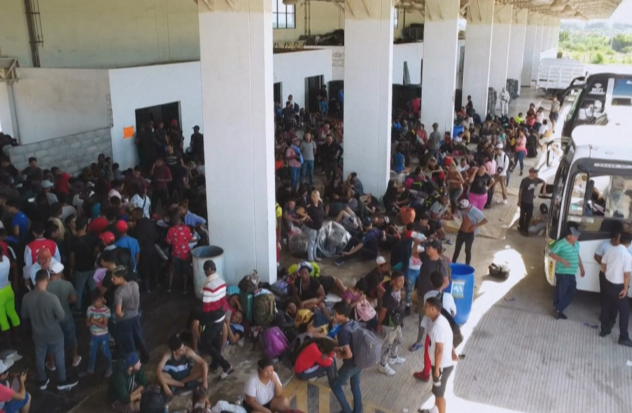From Mexico to Colombia, Ecuador and Peru, passing through El Salvador, Honduras or Guatemala, extortion has undermined citizen security. Its million-dollar profits place it behind drug trafficking or human trafficking, and it may be more profitable than illegal mining, according to intelligence sources consulted by AFP.
In Eduardo’s case, he learned about the attack through a video sent to his cell phone. “The owners of San Juan de Lurigancho”, a gang that operates in this district, the most populated in the Peruvian capital, with 1.2 million inhabitants, demanded an installation “tuition” of $13,300 and a monthly payment of $1,300. .
“I’m walking around almost in secret because I imagine that they have already studied everything, and they know where I live, where I have breakfast, where I have lunch, where I spend the night,” says this 40-year-old man who hides his true identity out of fear.
Small and large merchants, transporters, residential centers and entire towns are victims of local or international organizations.
In Peru, extortion even knocked on the doors of football. International attacker Paolo Guerrero was on the verge of giving up playing for the César Vallejo club due to threats to his family.
“We know who you are”
It is the same evil with multiple names: in Peru they are Los Pulpos, in Colombia it is the Clan del Golfo and in Ecuador, Tiguerones. There is also the feared Aragua Train of Venezuela, the most expanding organization of the last five years with presence in Colombia, Chile and Peru.
These groups have become “criminal companies” in search of markets and “partners in other countries,” says Peruvian anti-crime prosecutor Jorge Chávez.
Despite the intimidating power of these gangs, complaints have skyrocketed.
Last year Peru received 19,401 compared to 4,119 in 2021, an increase of 471% in two years.
In Ecuador, which is facing an unprecedented onslaught by drug traffickers, complaints increased by 482%, going from 2,801 cases in 2021 to 13,500 until September 2023.
In Colombia, where guerrillas and paramilitaries have also carried out extortion for decades, the figure has quadrupled since 2012: 2,316 cases compared to 9,297 last year, according to all official data.
And in Mexico, one extortion is reported every hour, according to the Coparmex business union.
Fear is spread with similar methods and messages.
“We know who you are, we already know what time your business opens (…) we know when you go to the market, we know where your child studies,” is the warning that has become common on WhatsApp, says Andrés Choy, president of the Association of Winemakers of Peru, which brings together 22,000 small merchants.
According to estimates, 13,000 of them were blackmailed last year. The next ad could be the “photo of your family member walking,” after which some close down or send their children abroad, he adds.
A 43-year-old widow with two daughters, Anita is another frightened victim. In January they launched an explosive and shot at the facade of her hardware store in Lima.
“The threats changed my life. I have to be hidden with my girls within four walls,” she laments.
“Parallel state”
The gangs have practically created a “parallel state”: they control territories to then establish a tax system, maintains Ecuadorian Colonel Roberto Santamaría, police chief of Nueva Prosperina, one of the most violent districts of the port of Guayaquil.
After imposing terror through threats, they ensure revenue by often employing minors who are unimpeachable. Another faction is responsible for attacking those who resist or fail to comply.
In a more sophisticated phase of the crime, one group cedes “the administration” of its area to another for a regular sum of money.
The colonel scales his financial muscle: in a single complex of 2,000 homes in Nueva Prosperina, each one was charged two dollars a day; 120,000 per month that can reach $200,000 with the collection of carriers.
In Colombia, control can extend to entire populations. In Buenaventura, its main port on the Pacific, with 311,000 inhabitants, “everyone has to pay” whether to “open a business, build or improve a building,” says Elizabeth Dickinson, an analyst with the NGO Crisis Group in Colombia.
From call center to AI
Faced with the advance of extortion, Peru created an elite force in November to combat this crime, whose methods have also changed.
In principle, the gangs extorted in exchange for guaranteeing the security that they themselves took away. Then came the drop-by-drop modality, small loans with weekly interest of up to 20%.
“When the ‘client’ cannot pay, the extortion issue begins: if you don’t pay, we will burn down your kiosk, grab your family, sister or children and injure them or if not, we will kill them,” says prosecutor Chávez.
Lately ‘call centers’ offer loans with a lower interest rate through an application, which victims download to their cell phones. They receive the money after sharing personal information, which is then used to blackmail the entire family.
Additionally, criminals are using artificial intelligence to create nude photos of women’s real faces. The image, with the message “I’m a whore, call me on this phone,” is circulated among some family and friends. In order not to make it viral, the victims have to pay, explains the prosecutor.
Despite the high impact of crime, in Peruvian prisons – from where countless extortion calls are also made – there are just over a thousand people convicted of this crime, less than 1% of the entire prison population.
And despite the fear, in many places, business continues: Eduardo finally opened his sauna and Anita continues with her hardware store.
Source: AFP

